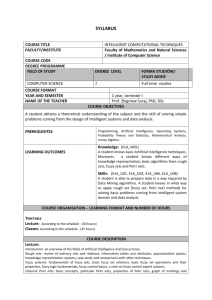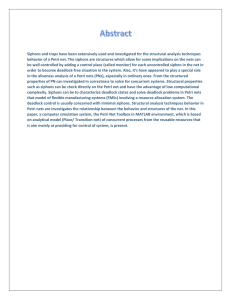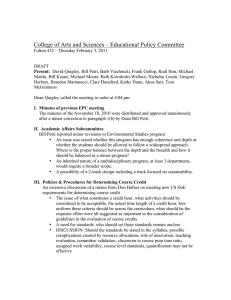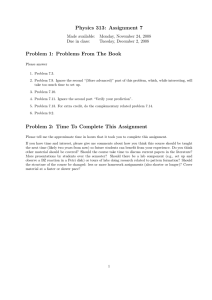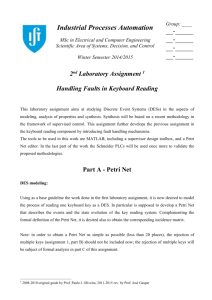Research Journal of Applied Sciences, Engineering and Technology 9(7): 485-490,... ISSN: 2040-7459; e-ISSN: 2040-7467
advertisement
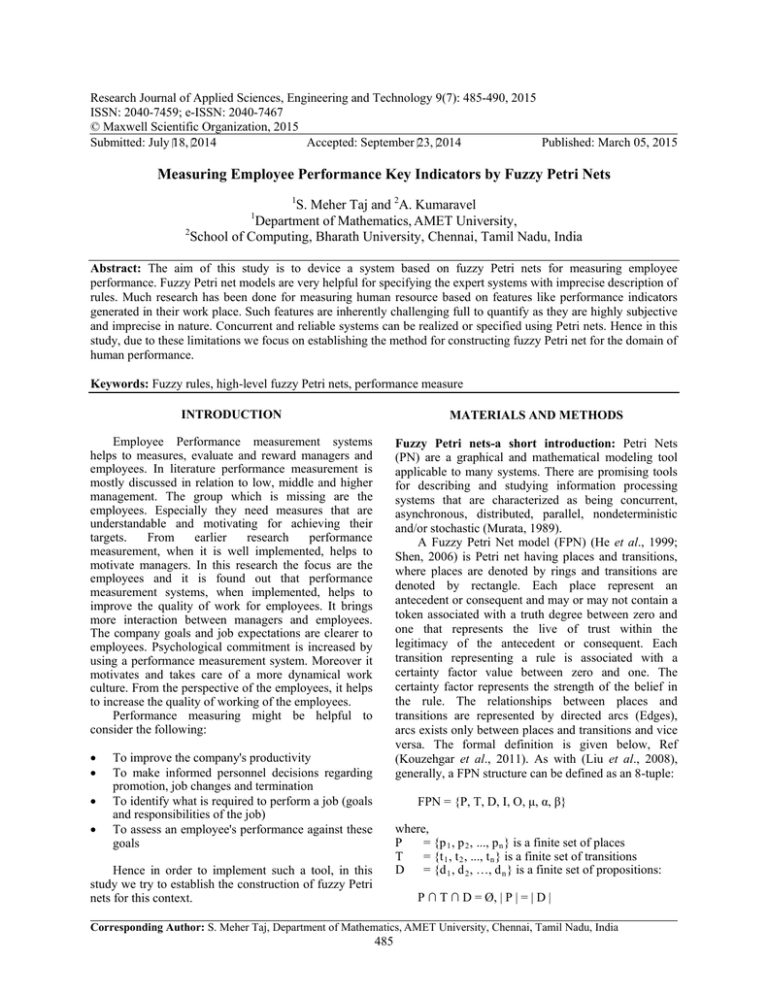
Research Journal of Applied Sciences, Engineering and Technology 9(7): 485-490, 2015
ISSN: 2040-7459; e-ISSN: 2040-7467
© Maxwell Scientific Organization, 2015
Submitted:
July 18, 2014
Accepted: September 23, 2014
Published: March 05, 2015
Measuring Employee Performance Key Indicators by Fuzzy Petri Nets
1
S. Meher Taj and 2A. Kumaravel
Department of Mathematics, AMET University,
2
School of Computing, Bharath University, Chennai, Tamil Nadu, India
1
Abstract: The aim of this study is to device a system based on fuzzy Petri nets for measuring employee
performance. Fuzzy Petri net models are very helpful for specifying the expert systems with imprecise description of
rules. Much research has been done for measuring human resource based on features like performance indicators
generated in their work place. Such features are inherently challenging full to quantify as they are highly subjective
and imprecise in nature. Concurrent and reliable systems can be realized or specified using Petri nets. Hence in this
study, due to these limitations we focus on establishing the method for constructing fuzzy Petri net for the domain of
human performance.
Keywords: Fuzzy rules, high-level fuzzy Petri nets, performance measure
INTRODUCTION
MATERIALS AND METHODS
Employee Performance measurement systems
helps to measures, evaluate and reward managers and
employees. In literature performance measurement is
mostly discussed in relation to low, middle and higher
management. The group which is missing are the
employees. Especially they need measures that are
understandable and motivating for achieving their
targets.
From
earlier
research
performance
measurement, when it is well implemented, helps to
motivate managers. In this research the focus are the
employees and it is found out that performance
measurement systems, when implemented, helps to
improve the quality of work for employees. It brings
more interaction between managers and employees.
The company goals and job expectations are clearer to
employees. Psychological commitment is increased by
using a performance measurement system. Moreover it
motivates and takes care of a more dynamical work
culture. From the perspective of the employees, it helps
to increase the quality of working of the employees.
Performance measuring might be helpful to
consider the following:
Fuzzy Petri nets-a short introduction: Petri Nets
(PN) are a graphical and mathematical modeling tool
applicable to many systems. There are promising tools
for describing and studying information processing
systems that are characterized as being concurrent,
asynchronous, distributed, parallel, nondeterministic
and/or stochastic (Murata, 1989).
A Fuzzy Petri Net model (FPN) (He et al., 1999;
Shen, 2006) is Petri net having places and transitions,
where places are denoted by rings and transitions are
denoted by rectangle. Each place represent an
antecedent or consequent and may or may not contain a
token associated with a truth degree between zero and
one that represents the live of trust within the
legitimacy of the antecedent or consequent. Each
transition representing a rule is associated with a
certainty factor value between zero and one. The
certainty factor represents the strength of the belief in
the rule. The relationships between places and
transitions are represented by directed arcs (Edges),
arcs exists only between places and transitions and vice
versa. The formal definition is given below, Ref
(Kouzehgar et al., 2011). As with (Liu et al., 2008),
generally, a FPN structure can be defined as an 8-tuple:
•
•
•
•
To improve the company's productivity
To make informed personnel decisions regarding
promotion, job changes and termination
To identify what is required to perform a job (goals
and responsibilities of the job)
To assess an employee's performance against these
goals
FPN = {P, T, D, I, O, μ, α, β}
where,
P
= {p 1 , p 2 , ..., p n } is a finite set of places
T
= {t 1 , t 2 , ..., t n } is a finite set of transitions
D
= {d 1 , d 2 , …, d n } is a finite set of propositions:
Hence in order to implement such a tool, in this
study we try to establish the construction of fuzzy Petri
nets for this context.
P ∩ T ∩ D = Ø, | P | = | D |
Corresponding Author: S. Meher Taj, Department of Mathematics, AMET University, Chennai, Tamil Nadu, India
485
Res. J. Appl. Sci. Eng. Technol., 9(7): 485-490, 2015
I : P×T→{0.1} is the input function, a mapping from
places to transitions
O : T×P→{0.1} is the output function, a mapping from
transition to places
μ : T→(0.1) is an association function, a mapping
from transitions to (0.1) i.e., certainty factor
α : P→(0.1) is an association function, a mapping
from places to (0.1) i.e., the truth degree
β : P→D, is an association function, a mapping from
places to proportions
benchmarks in the garment manufacturing industry by
always keeping to its quality and time commitments.
We conducted the survey very successfully and
collected the data as we planned; we partitioned the
data into 22 parts obtained from the answers. We also
categorize the data according to the nature of the
answers as input and internal properties. This is
described in the following sub section.
The input properties:
Work engagement:
Mapping the rule base to FPN: Throughout this
mapping technique, all principle is represented as
transitions with its relating certainty factor and each
antecedent is displayed by an input place and therefore
the consequents are incontestable by an output place
with scrutiny truth degrees. During this displaying a
transition here a suggestion is enabled to be fired if its
entire input place have a truth degree resembling or
over a predefined limit esteem. After firing the rule, the
output place can have a truth degree resembling the
input place truth degree multiplied by the transition
certainty factor.
•
•
•
•
•
•
•
•
•
•
Fuzzy Petri nets (Fpns): (Mintzberg, 1989; Meseguer,
1992; Shiu et al., 1996; He et al., 1999; Duric et al.,
2002; Dorsey and Coovert, 2003; Schermerhorn et al.,
2003; McNally, 2005; Kubota and Nishida, 2006;
Zhang et al., 2006; Okuda et al., 2007; Zhuomin, 2007;
Lokman et al., 2008; Li and Mingzhe, 2009; Ding
et al., 2009) are utilized for learning illustration what is
more thinking within the section of imprecise
information and learning bases. Fpns like AND-OR
neurons (Murata, 1989; Liu et al., 2008; Kouzehgar
et al., 2011) and with like Petri nets (Tousset, 1988) are
projected by Pedrycz.
Regularly, a collection of transitions emulated by a
collection of places constitutes a layer. An l-layered
like Petri net on these lines holds l-layers of moves
emulated by places and an additional embody layer
comprising of places simply. The places within the last
layer are known as closing place. Such a system has 2
types of benefits. To start out with, it will speak to
inaccurate learning like normal Fpns. Second, the
system may well be ready with a collection of inputoutput examples (as in an exceedingly food forward
neural net).
Celebrity fashions limited is one of India’s
consummate garments exporters with the capability to
manufacture the largest number of trousers in the
industry. The company has their own national premier
men’s wear brand, Indian terrain. The company has two
subsidiaries namely Indian terrain fashions Ltd and
Celebrity clothing Ltd. Our survey is based on the
Poonamallee branch (Chennai) of celebrity fashions ltd.
It has 1,000 employees working on it. Celebrity
fashions continuously upgrade its facilities to set new
•
•
•
•
•
•
•
•
•
•
•
•
At my work I feel energetic.
My job inspires me.
I am enthusiastic about my job.
At my job I feel strong and vigorous.
Service environment of my organization:
My organization does a good job keeping customers
informed of changes that affect them.
I understand management vision of my
organization.
Managers in my organization are very committed to
improving the quality of work.
Job satisfaction:
All in all am satisfied with my job.
In general I like working at my organization.
In general I do not like my job.
Personal attachment to my organization:
I am proud to tell others I work at my organization.
I feel strong sense of belonging to my organization.
Working at my organization means a great deal to
me personally.
I really feel that problems faced by my organization
are also my problems.
Reward from my job and organization:
When I do my work gives me a feeling of my
accomplishment.
When I perform my job well it contributes to my
personal growth and development.
When I do my work well receive a higher salary or
pay rise.
When I do my work well receive a higher bonus or
rewards.
Relationship with my superior:
My working relationship with my superior is
effective.
My superior considers my suggestion for change.
My superior and I are well suited to each other.
My superior recognizes my potential.
The internal properties: The inside properties of the
framework are made on the groundwork of some
arrangement of the info properties:
•
486
The input properties Q1 to Q4 form an internal
property called “Work engagement”.
Res. J. Appl. Sci. Eng. Technol., 9(7): 485-490, 2015
•
•
•
•
•
If Q11 to Q14 is ……then “Personal attachment to
my organization” is …….
If Q15 to Q 18 is ……then “Reward from my job
and organization” is …..
If Q19, to Q22 is ……then “Relationship with my
superior” is ……
The input properties Q5 to Q7 form an internal
property called “Service environment of my
organization”.
The input properties Q8 to Q10 form an internal
property called “Job satisfaction”.
The input properties Q11 to Q14 form an internal
property called “Personal attachment to my
organization”.
The input properties Q15 to Q18 form an internal
property called “Reward from my job and
organizations”.
The input properties Q19 to Q22 form an internal
property called “Relationship with my superior.
Level 2: Each of the unfilled spaces is loaded with a
linguistic value: Strongly disagree (vl), disagree (l),
Neutral (m), Agree (h), Strongly agree (vh). An
example principle base for the above careful
investigation could be displayed as an Employee
Performance Measuring (EPM) as the accompanying
structure indicated in Fig. 1:
As it where we have a fuzzy deduction in two levels.
Level one is supposed to deduce the internal
properties, level two is supposed to deduce the
employee’s performance based on the internal and input
properties.
EPM = (Emp, IPS, InPS, OPS, RS)
EPM.IPS = {“Q1, Q2, Q3, Q4, Q5, Q6, Q7 to
Q22”}
EPM. InPS = {Internal properties}
EPM.OPS = {Emp Per}
EPM.RS = {R1, R2 ......R10}
Level 1:
If Q1 to Q4 is ….. then “Work engagement” is …...
If Q5, to Q7 is ……then “Service environment of
my organization” is …..
If Q8 to Q10 is ……then “Job satisfaction” is …..
R1 = Q1 (vh) ^ Q2 (h) ^Q3 (m) ^Q4 (vh), “Work
engagement (vh)”
R2 = Q5 (m) ^ Q6 (h) ^Q7 (vh), “Service environment
of my organization (h)”
Fig. 1: The decision model
Table 1: Sample of dataset
Employees
-------------------------------------------------------------------------------------------------------------------------------------------------------------Questions
E1
E2
E3
E4
E5
E6
E7
E8
E9
E10
Q1
M
H
H
H
H
VH
H
H
VH
M
Q2
H
M
M
H
H
M
VH
L
M
VH
Q3
VH
M
M
M
H
VH
H
L
VH
H
Q4
M
VH
M
M
L
VH
M
M
M
M
Q5
H
M
H
M
VH
M
H
M
M
H
Q6
VH
H
H
H
H
H
VH
VH
H
VH
Q7
VL
L
L
VL
VL
M
M
H
L
M
Q8
H
L
M
H
H
H
H
H
H
H
Q9
VH
L
M
M
H
VH
H
H
M
VH
Q10
VL
M
VL
M
L
VH
VL
L
VL
L
Q11
H
VL
H
M
M
M
H
H
H
M
Q12
H
L
H
H
M
H
VH
L
H
M
Q13
VH
L
L
M
H
VH
VH
L
M
H
Q14
H
H
H
M
H
VL
H
M
H
VH
Q15
H
M
M
L
M
M
H
M
M
M
Q16
VH
L
M
M
M
H
VH
L
M
H
Q17
M
L
L
L
VL
VL
VH
H
L
M
Q18
L
L
L
M
VL
VL
VH
H
L
M
Q19
L
M
M
M
M
M
H
L
H
VH
Q20
H
L
H
L
H
M
M
M
M
H
Q21
M
M
L
M
H
H
VH
L
M
H
Q22
L
M
L
L
H
M
M
L
H
VH
487
Res. J. Appl. Sci. Eng. Technol., 9(7): 485-490, 2015
R3
R4
= Q8 (h) ^Q9 (m) ^Q10 (l), “Job satisfaction (h)”
= Q11 (m) ^Q12 (m) ^Q13 (l) ^Q14 (h),
Personal attachment to my organization (m)”
R5 = Q15 (m) ^Q16 (m) ^Q17 (h) ^Q18 (h),
“Reward from my job and organization (h)”
R6 = Q19 (m) ^Q20 (h) to Q21 (h) ^Q22 (vh),
“Relationship with my superior (vh)”
R7 = Q1 (h) ^Q2 (m) ^Q3 (h) ^Q4 (m), “Work
engagement (h)”
R8 = Q8 (vh) ^Q9 (h) ^Q10 (vl), “Job satisfaction
(vh)”
R9 = Work eng (vh) ^Ser envir (m) job sat (vh) ^Per
att (h) ^Rew (h) ^Rel with sup (vh),
“Employee performance (vh)”
R10 = Work eng (h) ^Ser envir (h) Job sat (h) ^Per att
(m) ^Rew (m) ^Rel with sup (m), “Employee
performance (h)” (Table 1)
represent the linguistic value: very low, low, medium,
high, very high, respectively. In the guideline, the
second component demonstrates the antecedent, the
third component indicates the consequent and the last
number demonstrates the certainty factor committed to
the rule. For instance Rule 1 is as follows:
EPM.R1 = Q1 (vh) ^Q2 (h) ^Q3 (m) ^Q4 (vh),
Work engagement (vh)
If Q1 is very high and Q2 is high and Q3 is
medium and Q4 is very high, then the work engagement
is very high.
The corresponding Petri net model is illustrated in
Fig. 2. In the Petri net model, according to the
proportions dedicated to each place, transitions 1 to 10
respectively represent rules 1 to 10 in the introduced
rule base above and firing each transition means the
corresponding rule is fulfilled.
In the above structure, Employee Performance
Measuring (EPM) is presented inside a 5-tuple
comprising of the Input Property Set (IPS), Internal
Property Set (InPS); Output Property Set (OPS) and
Rule Set (RS). Q1 to Q22 represent Question 1 to 22 as
input properties. Work engagement, Service
environment of my organization, Job satisfaction and
Personal attachment to my organization, Reward from
my job and organization and Relationship with my
superior as internal properties. Terms vl, l, m, h and vh
RESULTS AND DISCUSSION
In order to fulfill the rule base verification phase,
we must first map the rule base to Petri net as shown in
Fig. 2. Then as with the algorithm mentioned in (He
et al., 1999; Yang et al., 2003) a special reach ability
graph is generated on the basis of the concept of
ω-nets.
Fig. 2: CPN tool snapshot for EPM
488
Res. J. Appl. Sci. Eng. Technol., 9(7): 485-490, 2015
REFERENCES
Ding, W., L. Pei, H. Li, N. Xi and Y. Wang, 2009. The
effects of time delay of internet on characteristics of
human behaviors. Proceeding of the IEEE
International Conference on Networking, Sensing
and Control. Okayama, Japan.
Dorsey, D.W. and M.D. Coovert, 2003. Mathematical
modeling of decision making: A soft and fuzzy
approach to capturing hard decisions. Hum. Factors,
45(1): 117-135.
Duric, Z., W.D. Gray, R. Heishman, F. Li and
H. Wechsler, 2002. Integrating perceptual and
cognitive modeling for adaptive and intelligent
human-computer interaction. P. IEEE, 90(7):
1272-1289.
He, X., W.C. Chu, H. Yang and S.J.H. Yang, 1999. A
new approach to verify rule-based systems using
petri
nets.
Proceeding
of
23th
IEEE
Annual International Computer Software and
Applications Conference (COMPSAC’99), pp:
462-467.
Kouzehgar,
M.,
M.A.
Badamchizadeh
and
S. Khanmohammadi, 2011. Fuzzy Petri nets for
human behavior verification and validation. Int.
J. Adv. Comput. Sci. Appl., 2(12): 106-114.
Kubota, N. and K. Nishida, 2006. Prediction of human
behavior patterns based on spiking neurons.
Proceeding of the 15th IEEE International
Symposium on Robot and Human Interactive
Communication (RO-MAN06). Hatfield, UK.
Li, W. and W. Mingzhe, 2009. Extraction
and confirmation of rules for human decision
making. Proceeding of IEEE International Forum
on Information Technology and Applications
(IFITA’09), pp: 643-647.
Liu, F., M. Yang and P. Shi, 2008. Verification and
validation of fuzzy rules-based human behavior
models. Proceeding of 7th International Conference
on System Simulation and Scientific Computing
(ICSC, 2008) Asia Simulation Conference, pp:
813-819.
Lokman, J., J. Imai and M. Kaneko, 2008.
Understanding human action in daily life
scene based on action decomposition using
dictionary terms and Bayesian network. Proceeding
of IEEE 2nd International Symposium on Universal
Communication (ISUC’08), pp: 67-74.
McNally, B.H., 2005. An approach to human behavior
modeling in an air force simulation. Proceeding of
Winter Simulation Conference. Orlando, pp:
1118-1122.
Meseguer, P., 1992. Incremental verification of rulebased expert systems. Proceeding of European
Conference on Artificial Intelligence, pp: 840-844.
Mintzberg, H., 1989. Mintzberg on Management. 3rd
Edn., Free Press, New York.
Murata, T., 1989. Petri nets: Properties, analysis and
applications. P. IEEE, l7(4): 541-580.
Fig. 3: The reach-ability diagram
In this reach-ability graph, first, a zero vector is
defined as the root node as long as the range of places.
Then at any current marking, among the transitions yet
not considered, the enabled transitions are determined.
At every step by firing the set of enabled transitions, a
new node is added to the graph in which the
corresponding elements of the node-the places which
are filled after firing the transitions-are set to ω which is
assumed as an enormous price. During this manner at
every step there’s a marking. If firing of the transitions
at a step ends in an exceedingly repetitive marking, the
graph can have a loop.
The corresponding reach-ability graph for the
above Petri web model is portrayed in Fig. 3. The
places P0 to P28, 32, 35, 38 and 40, respectively are
regarded as TRUE antecedents and are initially filled
(set to ω) for this reason. That’s why in the initial node
there are thirty three ω’s. During this marking
transitions T1, T2, T3, T4, T5, T6, T7 and T8 are
enabled, respectively. Once firing these transitions,
within the second step, places P29, P30, P31, P33, P34,
P36, P37 and P39, respectively are filled and also the
corresponding values in the node vector are set to ω.
On the final step by firing T9 and T10 (the
enabled transitions), the places P41 and P42 will be
stuffed up.
CONCLUSION
The system based on fuzzy Petri nets has been
constructed and verified for an instance involving a
corporate context, celebrity fashions limited. This can
be extended with other key performance indicators.
ACKNOWLEDGMENT
The first author would like to thank the
management of AMET University for their support and
encouragement for this research study.
489
Res. J. Appl. Sci. Eng. Technol., 9(7): 485-490, 2015
Okuda, H., S. Hayakawa, T. Suzuki and N. Tsuchida,
2007. Modeling of human behavior in man-machine
cooperative system based on hybrid system
framework. Proceeding of IEEE International
Conference on Robotics and Automation. Roma,
Italy, pp: 10-14.
Schermerhorn, J.R., J.G. Hunt and R.N. Osborn, 2003.
Core Concepts of Organizational Behavior. 3rd
Edn., John Wiley and Sons, New York.
Shen, V.R.L., 2006. Knowledge representation using
high-level fuzzy Petri nets. IEEE T. Syst. Man Cy.
A, 36(6): 1220-1227.
Shiu, S.C.K., J.N.K. Liu and D.S. Yeung, 1996. An
approach towards the verification of fuzzy hybrid
rule/frame-based expert systems. Proceeding of
12th European Conference on Artificial
Intelligence. John Wiley and Sons, Ltd.
Tousset, M., 1988. On the consistency of knowledge
bases: The COVADIS system. Proceeding of
European Conference on Artificial Intelligence, pp:
79-84.
Yang, S.J.H., J.J.P. Tsai and C. Chen, 2003. Fuzzy rule
base systems verification using high-level Petri
nets. IEEE T. Knowl. Data En., 15(2): 457-473.
Zhang, H., L. Rui and S. Jizhou, 2006. An
emotional model for nonverbal communication
based on fuzzy dynamic Bayesian network.
Proceeding of Canadian Conference on Electrical
and Computer Engineering, pp: 1534-1537.
Zhuomin, S., 2007. Multi-agent based modeling:
methods and techniques for investigating
human behaviors. Proceeding of the IEEE
International Conference on Mechatronics and
Automation. Harbin, China.
490
